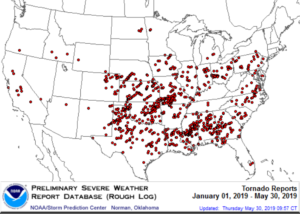The headlines on our phones scream it out: “A Month of Mayhem,” says USA today. “At least 225 Twisters in 12 Days,” writes the Washington Post.
For parts of the United States this May, tornadoes ripping across the land makes it feel like the movie Groundhog Day. The storyline of that movie had Bill Murray waking up each morning to relive the same day he lived yesterday.
During the last couple of weeks, thunderstorms have developed each day across the central U.S., powered up into supercell thunderstorms, and then created between a few to a few dozen daily tornadoes. Here’s a look at where people reported tornadoes January-May 2019:
Tornado Records Broken?
There are so many ways to look at tornado records. The most in a day, for example. Or the most EF-3 classified tornadoes in a month, for example. The list goes on.
“If you want to use the number of consecutive days with any confirmed tornado, that is 70 straight days, with July 1, 1991, being the last day in that stretch with a tornado,†Dr. Patrick Marsh, a warning coordination meteorologist at the SPC told AccuWeather.
Because tornadoes are often reported by several people, it takes the National Weather Service considerable time to visit each damage path and figure out if there was one tornado, multiples in a small area, or perhaps damage that looked like a tornado but was from straight-line winds instead.
When these meteorologists get down to the actual number of confirmed tornadoes, I won’t be surprised if some sort of records were broken. However, most of the previous tornado records in the U.S. should be left standing, unlike many communities in the central and southeastern U.S.
May 2019 Tornadoes: Why It Was Good Timing
It seems hard to believe right now, but the dozens and dozens of tornadoes to hit the U.S. could save lives and advance the ability to predict tornadoes like never before.
That’s because of an unprecedented tornado research project that started just days before the May tornadoes did.
Called the TORUS project, it is happening across 367,000 square miles, stretching from North Dakota to Texas and Iowa to Wyoming and Colorado. As this video explains, researchers are even launching unmanned flying objects into storms that can generate tornadoes:
NOAA, the lead government agency on the research project, explains what’s happening and the reason NOAA calls is the TORUS project.
“Targeted Observation by Radars and Unmanned Aircraft Systems of Supercells, or TORUS.
The TORUS project involves more than 50 researchers using 20 tools to measure the atmosphere, including unmanned aircraft systems, mobile radars and NOAA’s WP-3D Orion “Hurricane Hunter†aircraft.
During the project, scientists will test miniaturized, high-precision, and fast-response atmospheric sensors adapted for use on the UAS (unmanned aircraft systems).”
The tiny sensors will reveal never before seen details of supercell thunderstorms and what contributes to tornadoes forming.
Hopefully, June 2019 will be a slower “tornado month” across the central United States. But at least there is this silver lining: each tornado that touches down through June 16 can be more than tragic.
It can also provide valuable information that saves lives for decades to come.


I always read your posts and thanks for the education. This is how we learn Thanks and keep posting! Linda Jackson, Seal Rock, Oregon
Thank you, Linda, I appreciate it!
Thanks Bruce for the insight and information . Really enjoy these updates . Keep them coming. It’s still rough not seeing you on air . We are total fans, however this way we are able to still plan and go! Thanks much for your accuracy always
Layne Bailey